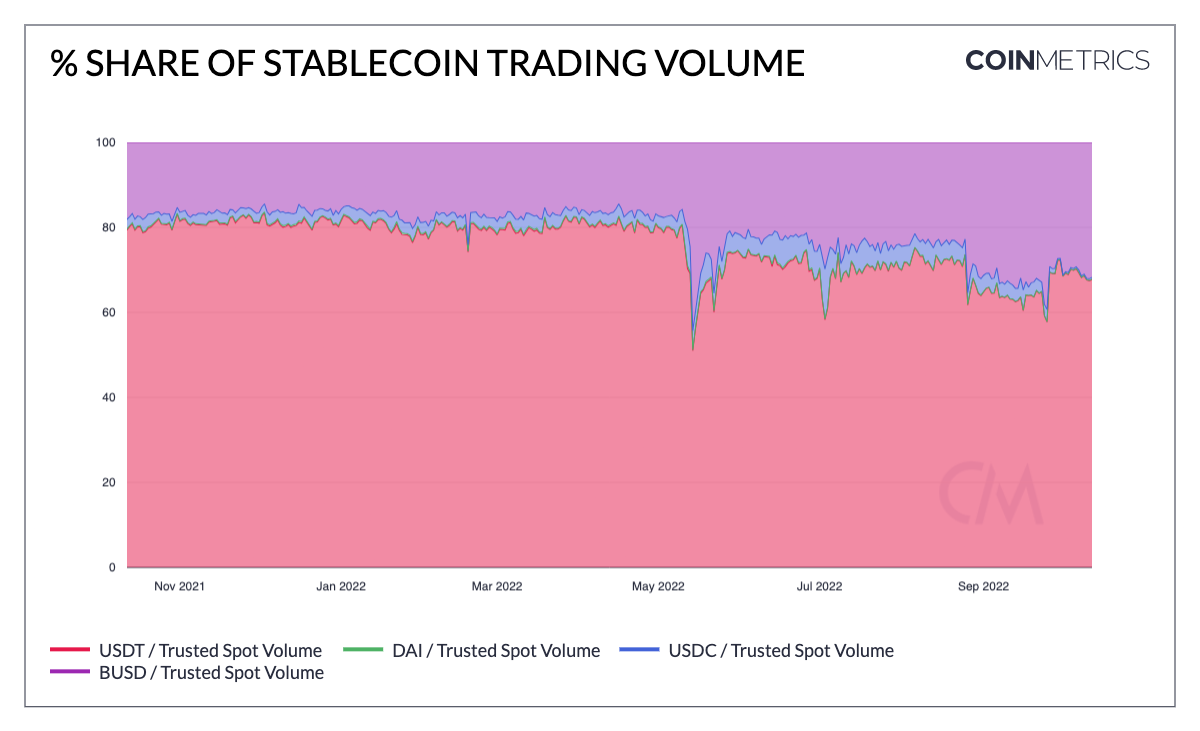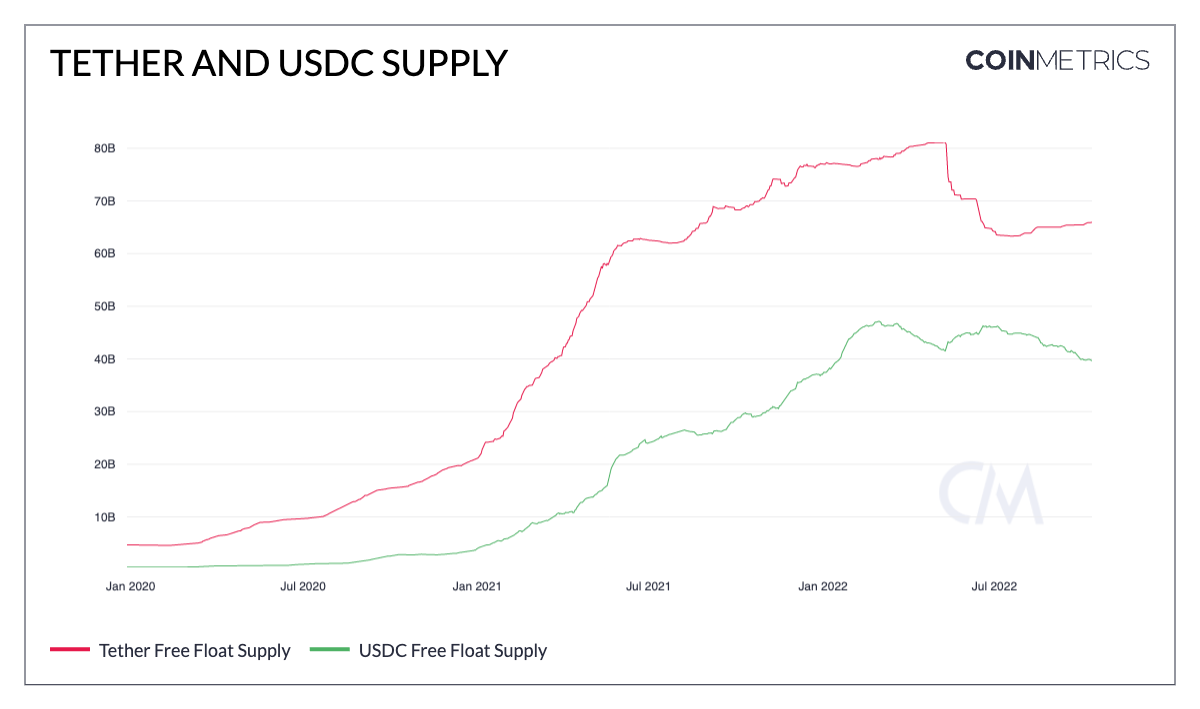Coin Metrics' State of the Network: Issue 177
Tuesday, October 18th, 2022
Get the best data-driven crypto insights and analysis every week:
Stablecoins Come Into Focus in EU’s MiCa Legislation
By Matías Andrade, Kyle Waters, and Nate Maddrey
Stablecoins are one of the most fascinating products in the cryptocurrency ecosystem in spite of their, well, stability. But in the stablecoin ecosystem there are many things worth keeping in mind, and recent changes have brought fresh developments in what is sometimes called crypto’s leading killer app. The total market cap of stablecoins has fallen in 2022, but is at least $135B today.
Source: Coin Metrics Network Data
Regulatory guidance and oversight are topics that regularly intrude in the stablecoin market and are sure to shape the future of the ecosystem. Last week, the European Council voted in favor of the EU’s Markets in Crypto Assets (MiCA) legislation, set to come into force in 2024, to provide greater transparency and accountability to individuals and businesses operating in the crypto industry with stablecoins given special treatment. In particular, the new rules forbid the collection of interest by investors on stablecoins, which could provide motivation for securitization of tokenized retail money-market funds or commercial bank deposits, which do not fall under MiCA and are free to pay interest.
Furthermore, MiCA pursues mandatory disclosure of “adverse impacts on the climate and other environment-related impacts [driven by] consensus mechanisms.” Recent transition to Proof-of-Stake by Ethereum poses an interesting case-study—by reducing the energy consumption of consensus activities in the order of 99.5 percent, it may reduce liability and promote acceptance of Ethereum-based stablecoins.
Finally, one of the more consequential changes proposed is a limit on daily traded volume of non-euro stablecoins at €200M. With the overwhelming majority of stablecoins being USD-denominated, EU officials are recognizing the proliferation of the US dollar abroad via stablecoins. Circle’s USD Coin (USDC) boasts a total supply of over $45B while its Euro stablecoin counterpart (EUROC) only had a supply of €76M in August (though EUROC is a newer offering).
In another shakeout in the stablecoin ecosystem, Binance — the world’s leading cryptocurrency exchange by volume — recently announced in September that all user holdings in USDC, USDP and TUSD (alternative stablecoin offerings) would be converted automatically to BUSD (Binance’s stablecoin) when deposited onto the exchange. This decision is justified by Binance as an attempt to improve liquidity by consolidating order books into a single stablecoin pair, as well as increase demand for their own stablecoin. BUSD supply recently surpassed $21B, while USDC supply has tilted downward in recent months. The fast changing interest rate environment in the US and abroad has also contributed though, as stablecoin holders are likely seeking to capture yield elsewhere in the financial markets.
Source: Coin Metrics Network Data Pro
BUSD’s share of spot volume has grown as it is being used more frequently as a quote asset on Binance. USDT continues to dominate trading volumes in centralized exchange markets, and USDC receives relatively little use, especially after Binance’s decision to deprecate USDC-quoted spot pairs on the exchange. However, USDC remains a popular quote asset for trading on decentralized exchanges (DEXs) and dominates in DeFi more generally.
Source: Coin Metrics Network Data
Velocity is an interesting metric to gauge stablecoin activity. It measures the relative turnover in token value between accounts taking place in each tokens’ respective network. Velocity is thus proportional to transaction size and frequency. We can see that DAI has rapidly grown in popularity as a result of its considerable on-chain footprint, dominating over all other tokens, thanks to popularity as collateral and quote in DeFi. Although this is in part because other tokens receive greater use off-chain on centralized exchanges, it is remarkable that USDC velocity is increasing, even if it is far below the velocity observed for DAI.
Source: Coin Metrics Network Data
We have seen both Tether and USDC supplies decrease this year as tokens are redeemed and removed from circulation. Tether supplies have stabilized at around $67B after almost $18B in redemptions. USDC (on Ethereum) has decreased in supply and is approaching $40B after reaching a high point of almost $48B on February of this year.
Source: Coin Metrics Network Data
The low-value transfer market is dominated by USDT tokens issued in the Tron network. These tokens benefit from low fees and rapid transaction processing of the Tron platform, which are especially important for cost-sensitive users. This relative dominance is clearly visible in the chart below.
Source: Coin Metrics Network Data Pro
In the US, regulators are also moving closer to stablecoin legislation. A recent US Treasury report laid out some considerations that could be reflected in upcoming legislation, including a two-year ban on algorithmic stablecoins.
To follow the data used in this piece and explore our other on-chain metrics check out our free charting tool, formula builder, correlation tool, and mobile apps.
Network Highlights
Summary Metric
Source: Coin Metrics Network Data Pro
Most assets show signs of stagnating on-chain activity, with decreasing numbers of active addresses. But some assets showed strong growth week-over-week with LTC daily active addresses rising 75% and ALGO daily active addresses rising 60%.
Coin Metrics Updates
This week’s updates from the Coin Metrics team:
For the best in-depth discussion of CM data and research, come check out our research community on the web3 social media platform gm.xyz.
Check out Coin Metrics’ market-data focused newsletter State of the Market.
As always, if you have any feedback or requests please let us know here.
Subscribe and Past Issues
Coin Metrics’ State of the Network, is an unbiased, weekly view of the crypto market informed by our own network (on-chain) and market data.
If you'd like to get State of the Network in your inbox, please subscribe here. You can see previous issues of State of the Network here.
Check out the Coin Metrics Blog for more in depth research and analysis.
© 2022 Coin Metrics Inc. All rights reserved. Redistribution is not permitted without consent. This newsletter does not constitute investment advice and is for informational purposes only and you should not make an investment decision on the basis of this information. The newsletter is provided “as is” and Coin Metrics will not be liable for any loss or damage resulting from information obtained from the newsletter.








